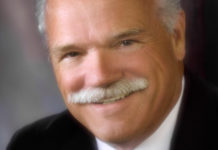Below is what happens when a writer is somewhat confined to his immediate surroundings; that writer reads a lot of books and views a lot of documentaries and then sits down at the keyboard and just lets the fingers go where the imagination, and conscience, takes them. Such is the case below, and it is not the only bit of whimsy written over the years; most all unsaved so lost forever.
***
Special Report: Dateline Salinas Valley of California
By Western News Association Correspondent E. M. Pathy
The earthquake that struck the West Coast of the United States on April 13 of last year, 19 months ago, still has not been intensity rated as most of the facilities and campuses housing seismic monitoring equipment were destroyed. In areas further away from the epicenter, the upset caused by the tremor so rattled monitors that consensus of where on the Richter scale it registered is still an issue of dispute, but it has been determined to definitely be no lower than 7.9 and possibly up to 9.3. No matter the actual number, it was a cataclysmic event with the loss of tens of thousands of lives and a geological rearranging of the western United States and beyond.
The initial response to the event was an inevitable disaster in itself as federal, state, county and municipalities created a morass of bureaucratic red tape, while tens of millions of inhabitants of five states struggled to survive. In Washington, Oregon and California, the dual movements of the San Andreas Plate and the Juan de Fuca Plate created widespread loss of life and months of the absence of electricity and potable water. Dams were either destroyed or damaged and the resulting floodwaters washed human and animal corpses into thousands of water treatment facilities and incapacitated hydroelectric plants.
National security measures were instituted throughout the nation as concerns about the reactions of foreign nations to the dire situation in which the United States found itself; Russian, North Korean, Chinese and Middle Eastern representatives were known to be in constant contact, while the military forces of all of these powers began movements and exercises that were believed by analysts to be a coordinated attack against the United States when the nation was at its weakest. For this reason, the Western United States was left on its own to deal with the massive aid now needed for survival.
While the damage and loss of life in large cities captured what news coverage was possible, there was the unreported losses in smaller towns or those areas that became isolated due to destruction of roads and bridges. Nearly 10 months after the tremor hit the West Coast and resulting tsunamis had decimated vast sections of lower Alaska and had all but inundated Hawai’i, the federal government set up large facilities offering what medical aid and food and clothing it could muster under the circumstances.
For the most part, these facilities were understaffed and under stocked and the influx of tens of thousands of desperate people became such a security issue that the Army Corps of Engineers built 15-foot-high wire fences surrounding each of the four facilities. One facility was established in the Salinas Valley of Central California, and though smaller than its counterparts in the San Joaquin Valley or the Mojave Desert, it still suffered from lack of clean water, food, clothing and medical supplies.
Reports that trickled out of the small valley, once the home of eight towns and a dozen outlaying populated areas, were the same as reported on at the larger facilities: dozens of small encampments where children suffer from lack of food, water and clothing, parents sacrificing their own needs for the young and the elderly and roving bands of gangs who steal what they want and target young girls for their own needs. Given the widespread destruction that either completely destroyed homes or made them too dangerous for even the basest shelter, many families found themselves in these encampments.
Field worker families and single people were sheltered side-by-side with families who own the fields and agricultural plants wherein they once worked. People whose backgrounds are English, Filipino, Swiss-Italian, Irish, Middle Eastern and Italian all found themselves in tents and make-shift shelters all in close quarters and all facing the same challenges. All of these faces, faces of different colors, suffered the same humiliation and loss of dignity no matter their lot in life. All long for family gathered around a well-set dinner table, all long for the luxury of a warm shower or bath, for clean clothing and most of all, they long for the freedoms lost. They all want all that life in America once held for them.
The day will come when the federal facilities will no longer be needed, when infrastructures are repaired or replaced and when, finally, some semblance of normalcy will be restored to the devastated areas; but it will take many, many years to heal all the scars, both to the landscape and to the human’s psyche, but heal they will. And the time will come for many when the freedoms and stability they once had will be once again invested in their lives.
***
This particular imagining of what it would be like to know the actual people who could be affected in such a calamity was pretty vivid. I cringed at the thought of some of the seniors, like myself, with whom I’ve worked who would be tossed into such conditions. I felt for parents unable to provide or protect their families, and I became enraged at the thought of what could happen to young girls with whom I had once shared so many magical times.
Writing can get emotional. But this is all fiction and nothing more, so we need not get too involved, do we?
By the way, the idea for this column came after I watched a documentary showing what is happening, and has been happening for a few years now, at the border between Mexico and the United States. And that is not fiction.
Take care. Peace.













